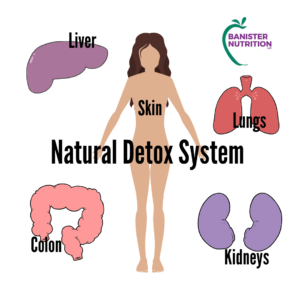5 Safe Ways to Detox this Summer
 Detoxing was once only known as a medical procedure to rid the body of dangerous, often life-threatening, levels of alcohol, drugs, or poisons.
Detoxing was once only known as a medical procedure to rid the body of dangerous, often life-threatening, levels of alcohol, drugs, or poisons.
Over the years, this term has been touted as a way to rid the body from toxins that cause symptoms from headaches to joint pain to depression.
The truth is, a detox lacks essential nutrients, such as proteins and fatty acids to keep our body healthy. In a healthy body, the skin, kidneys, lymphatic system, gastrointestinal system, and most importantly, the liver make up an astoundingly complex and sophisticated detoxification system.
Our lungs detoxify by removing gases, skin provides a barrier to protect us from outside substances, the colon detoxifies by eliminating waste from our bodies, kidneys filter toxins out of the blood into the urine and the liver detoxifies by filtering blood as well as secreting bile for digestion.
Here are 5 Safe Ways to Detox this Summer
1) Cut Back on Alcohol
In 2018, researchers found that 40 percent of American adults consume excessive amounts of alcohol. Ethanol has been identified as a known carcinogenic and can increase the risk of cancers in the mouth, liver, and breast.
Depending on who you are, drinking alcohol, moderately and responsibly, can lower cardiovascular risk.
2) Eat More Fruits and Vegetables
Fruits and vegetables provide dietary fiber to help maintain bowel regularity. Fiber is even found in nuts, seeds, and whole grains. A variety of these foods support the body’s natural detoxification.
3) Unplug
It’s so easy to get wrapped up in the instant gratification literally at our fingertips. We have the ability to order items and have them delivered within hours. We mindlessly scrolling through feeds without realizing how much time has passed. You CAN detox simply by putting down the phone and connecting with the people around you. Unplug for an hour or even an entire day, if you can.
4) Move Your Body
You don’t need to pick up a rigorous plan. Ride your bike, walk in the park, go for a swim. In reality, the best physical activity is one you enjoy, but also the one you can easily fit into your daily schedule.
5) Get your ZZZ
Sleep deprivation has been linked to weight gain in adults and children. Children as young as 4 years old can have adverse effects from lack of sleep. A 2013 study published in Science, showed that during sleep the glymphatic system lets fluid flow rapidly through the brain. The glymphatic system helps control the flow of cerebrospinal fluid (CSF), a clear liquid surrounding the brain and spinal cord. The glymphatic acts as a “flushing system” to remove toxins, which appears to be the most active during hours of sleep.
If you have questions about how you can better support your body’s detoxification, contact our dietitians at Banister Nutrition. We can provide personalized nutrition counseling to meet your lifestyle, preferences and health-related needs.
Xie et al “Sleep initiated fluid flux drives metabolite clearance from the adult brain.” Science, October 18, 2013. DOI: 10.1126/science.1241224
